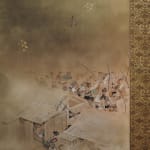Maeda Seison (1885–1977)
In the Midst of a War
Color and gold on silk, hanging scroll
With a Tokyo Art Club certificate,
a box signed by the artist, double boxed
Seal: Seison
124 x 56 cm
225 x 73 cm (overall)
With a Tokyo Art Club certificate,
a box signed by the artist, double boxed
Seal: Seison
124 x 56 cm
225 x 73 cm (overall)
Further images
The title of this work, Tatakai takenawa, literally means “in the midst of a war.” Troops, as if to fill all the narrow streets between the townhouses, armed with swords, bows and arrows, shouted loudly, and surged in crowds towards the right edge of the painting. Over half of the space is occupied by clouded sky, which in turn emphasizes the proceeding of the troops and greatly intensifies the atmosphere of the scene. The imperial decree rolled over the pole and the cakraratana shinning above the sky indicate that this is by no means a mere battle. Judging from the hakogaki by Maeda Seison “the divine fight above the sky; and human combat on the ground,” and his works on similar subject, this painting might be depicting a scene from “Mikoshiburi,” the first volume of Tales of Heike.
Troops at Enryaku-ji temple appealed to the Emperor for the exile of the governor Kaganokami Morotaka, and the imprisonment of his younger brother Kondo Morotsune. As the appeal was not responded, the troops postponed the Hiyoshi Matsuri, and proceeded to the capital (current Kyoto) with divine palanquins ahead. The present work might be depicting the scene as written in the book:
The divine palanquins reached Ichijo Street and headed for the west. The sacred treasure shines above the sky,
as if the sun and the moon have dropped to the ground.
Moreover, Seison’s hakogaki is probably referring to “the shouting went through to the heaven, even the god of the earth was shocked” as described in the book.
Maeda Seison (nihonga painter; 1885–1977)
Gifu-born nihonga painter. His real name is Renzo. A student of Kajita Hanko. A member of nihonga societies Songa-kai and Koji-kai. Recognized as three exceptional painters at Nihon Bijutsuin (Japan Art Institute) together with Kobayashi Kokei and Yasuda Yukihiko. Particularly excelled at history, figure, and kacho (flower-and-bird) works. His work features refined lines and the tarashikomi (dripped in) technique. Member of Teikoku Bijutsuin (Imperial Fine Art Academy), an Imperial Court Artist, and a Nitten (Ministry of Education Art Exhibition) juror. Appointed Tokyo University of the Arts professor. Designated as a Person of Cultural Merit, and received the Order of Culture.
Troops at Enryaku-ji temple appealed to the Emperor for the exile of the governor Kaganokami Morotaka, and the imprisonment of his younger brother Kondo Morotsune. As the appeal was not responded, the troops postponed the Hiyoshi Matsuri, and proceeded to the capital (current Kyoto) with divine palanquins ahead. The present work might be depicting the scene as written in the book:
The divine palanquins reached Ichijo Street and headed for the west. The sacred treasure shines above the sky,
as if the sun and the moon have dropped to the ground.
Moreover, Seison’s hakogaki is probably referring to “the shouting went through to the heaven, even the god of the earth was shocked” as described in the book.
Maeda Seison (nihonga painter; 1885–1977)
Gifu-born nihonga painter. His real name is Renzo. A student of Kajita Hanko. A member of nihonga societies Songa-kai and Koji-kai. Recognized as three exceptional painters at Nihon Bijutsuin (Japan Art Institute) together with Kobayashi Kokei and Yasuda Yukihiko. Particularly excelled at history, figure, and kacho (flower-and-bird) works. His work features refined lines and the tarashikomi (dripped in) technique. Member of Teikoku Bijutsuin (Imperial Fine Art Academy), an Imperial Court Artist, and a Nitten (Ministry of Education Art Exhibition) juror. Appointed Tokyo University of the Arts professor. Designated as a Person of Cultural Merit, and received the Order of Culture.









